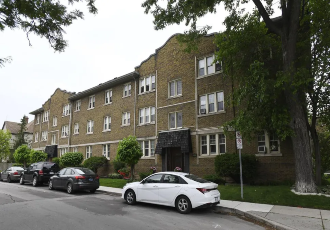
Worried about the future, Hamilton tenants aim to buy landlord’s building
Renters plan to form co-op to preserve affordable rates
Alarm bells went off when the tenants of an old, low-rise apartment block just south of downtown Hamilton heard their home was for sale.
The all-too-familiar pattern of investors scooping up buildings to renovate them and jack rents played out in their minds.
Rachel Cadesky, a 38-year-old nursing student and single mom who pays $1,250 a month, wondered where she and her two small children would end up.
“Initially, I panicked because I assumed that we were going to be out.”
James Reynolds, 76, was similarly spooked by the spectre of having to find another affordable place to live in Hamilton’s escalated rental market.
“I would probably end up living in some dive somewhere,” said Reynolds, a 30-year resident whose bachelor pad is $544 a month.
But tenants at 272 Caroline St. S. are breathing easier these days, with a plan to buy the 21-unit building from their landlord and turn it into co-operative rental housing that preserves its affordable rates.
With a conditional purchase-sale agreement inked for the property — which the owner initially listed at $5.25 million — they’re working to close the deal.
Long-term tenants in the stately, 90-year-old, brick building at Herkimer Street have benefitted from rent control that sets annual caps on increases.
But once units become vacant in Ontario there’s no limit on how high landlords can hike rents, a policy that tenant advocates say has fuelled evictions for renovations.
The average rent of a two-bedroom apartment in Hamilton eclipsed $2,300 last month, according to the latest national report from Rentals.ca. One-bedroom units go for $1,877 a month.
“Everyone in Hamilton either has a family member or a friend who has gone through a ‘renoviction,’ or been faced with a major rent hike in the last few years,” said Emily Power, another tenant at 272 Caroline.
“The gentrification of the city is putting pressure on so many people and this is due to the financialization of housing.”
Under the rental co-op model, the tenants set rates, take charge of paying the mortgage and ensure there’s enough in a pot to cover maintenance and repairs. The property is owned by the co-op, not individual tenants.
That arrangement, and the ability for renters to buy buildings as they hit the market with the help of public funds, could help preserve existing affordable stock, says Power, a 29-year-old urban planning student and experienced tenant organizer.
“I think this is a great model and could easily be replicated across Hamilton for other tenants to benefit from.”
The 272 Caroline plan involves a few moving parts — some in place and others still to be worked out.
Non-profits, including the Hamilton Community Foundation, have helped along the way as the tenants secure a low-interest loan through the Canada Mortgage and Housing Corporation (CMHC).
A donor, who Power says wishes to remain anonymous, stepped up to ensure the tenants could make a $100,000 deposit to secure their conditional purchase-sale agreement.
And this week, city councillors gave initial approval for an $84,000 grant to help the tenants with their down payment.
In August, staff expect to report back on flowing rent-geared-to-income subsidies for about half of the tenants in the building. Property tax abatement is also in the works.
Coun. Cameron Kroetsch agrees the 272 Caroline scenario serves as an “excellent model” to slow the erosion of affordable rentals from Hamilton’s private market.
But there’s more work ahead if the city wants to lend a greater hand, says Kroetsch, whose pitch to use ward-specific funds to help with the down payment gained unanimous support Thursday.
“There’s no chance that we have a sustainable model set up at this point to do this in a really broad way.”
A fund to help non-profits buy rental buildings when they hit the market is a key strategy in Hamilton’s new Housing Sustainability Investment Roadmap.
“We’re bringing forward a further financing strategy later this year with respect to what acquisition could really look like on a bigger scale,” housing director Michelle Baird said.
The city is helping, but Kroetsch also gives ample credit to the tenants for taking charge of their destinies.
“It came from their strength as a community and their organizing to make this happen.”
Building owner Andrew Robertson, meanwhile, says he’s also impressed with how the tenants rolled up their sleeves.
“I was floored. You’ve got 21 people signing on ... That’s really an accomplishment.”
The real estate broker says he has fielded expressions of interest in the building, but also lowball offers.
“There’s some heavy-duty investors looking at this, and rightfully so. It’s a beautiful building, so it has tremendous potential.”
But don’t chalk up the conditional deal with his tenants to charity, Robertson says.
“I support them, but at the end of the day, it’s just a business decision for me.”
For the tenants, it’s something else.
“I retired into this home,” says Reynolds, a former railway worker and resident handyman. “And I want to be here for whatever’s left of my life.”
Article courtesy of Teviah Moro, a reporter for the Spectator
